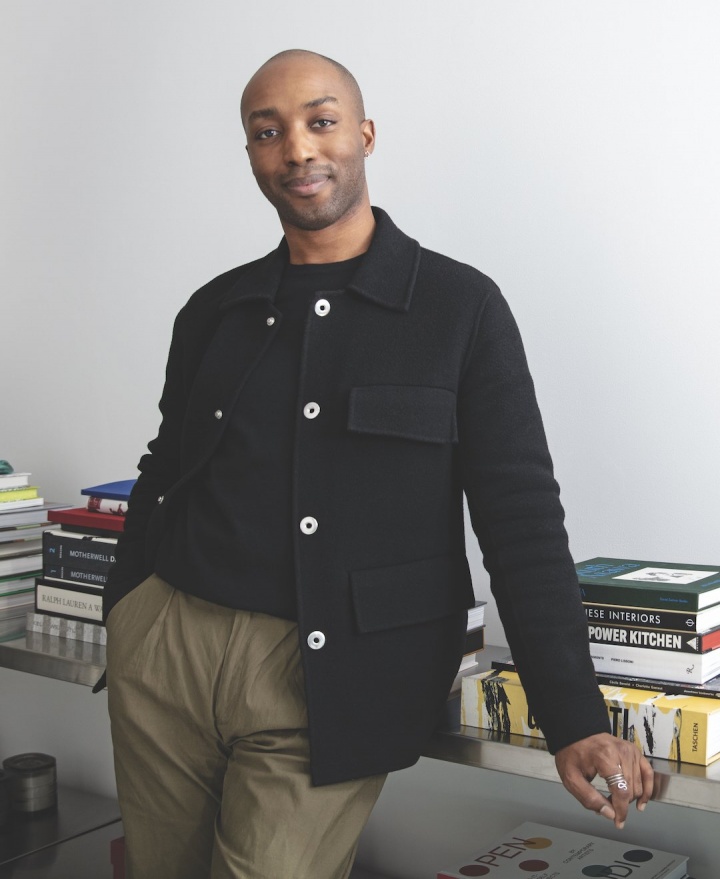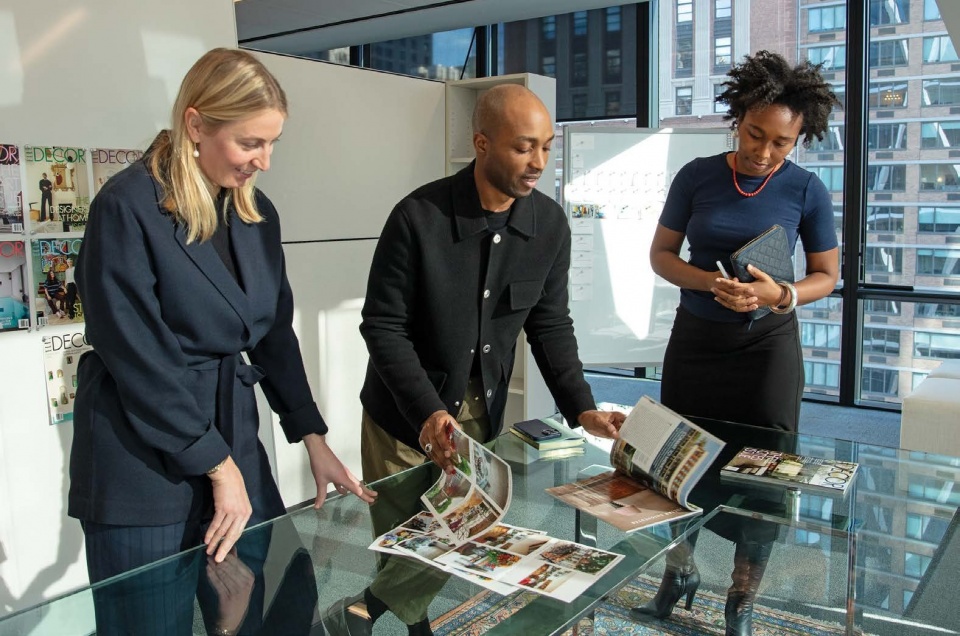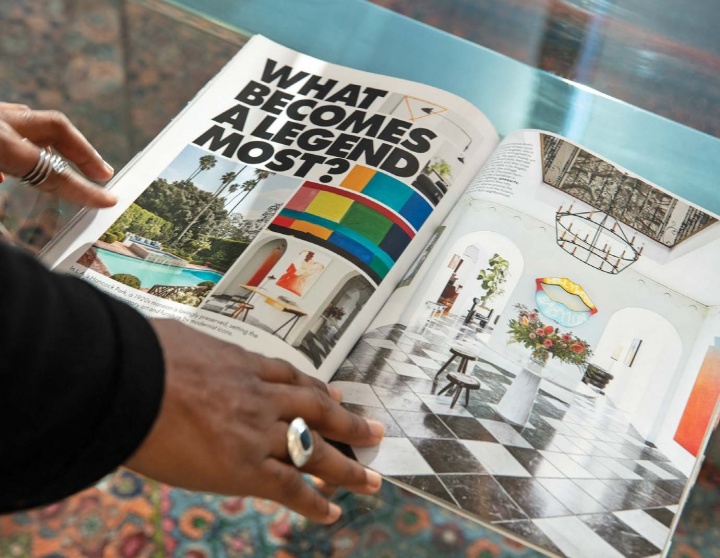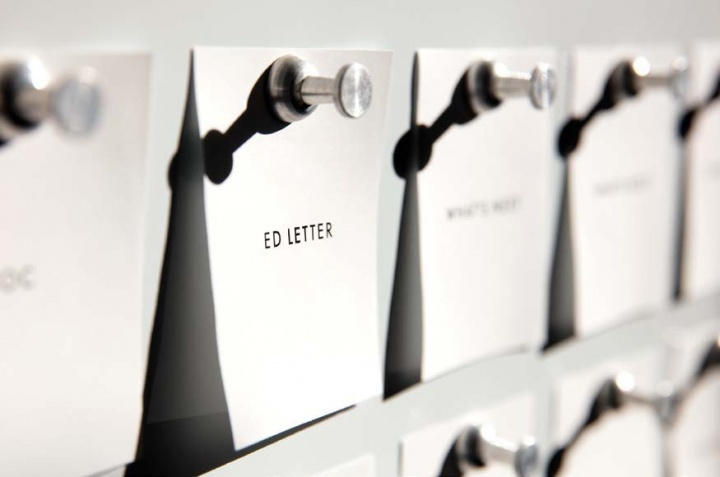Editor-in-chief Asad Syrkett ’11 is redesigning the mission at Elle Decor.
Columbia College | Columbia University in the City of New York
Editor-in-chief Asad Syrkett ’11 is redesigning the mission at Elle Decor.

Photographs by Jörg Meyer
These are the questions that are top of mind for Asad Syrkett ’11. As the editor-in-chief of Elle Decor, the glossy Hearst brand that feasts the eyes of more than half a million subscribers and 4.4 million Instagram followers, his editorial mission is to “inspire readers to make their worlds more beautiful, one room at a time.”
Even just skimming the Elle Decor website is a euphoric experience, a perfect marriage of sumptuous photography and clever headlines. Style lovers are treated to home tours (“This Chic Ibiza Escape Is a Full-On Party House”); design trends (“The Future of Color Is Pretty Much ‘Barbenheimer’”); and life and culture hot takes (“Beetlejuice Is the Ultimate Home Reno Movie”).
But Syrkett also believes that beauty should not just be surface deep. “Interior design magazines have always been about fantasy — always,” he says. “But I do feel we have a responsibility to engage with things that are happening in reality.”
Things were quite real in September 2020 when Syrkett took the magazine’s helm. Working virtually, he and the Elle Decor team got busy creating content for the moment, polling the design community about how Covid-19 had upended our relationships to home, and adding more experiential personal essays to the mix. Unable to develop in-person show houses, the brand collaborated with the newly established Black Artists and Designers Guild on a virtual concept house that launched in January 2021.
Since then, Syrkett has prioritized opening doors: from featuring more diverse representation (in the magazine’s pages, as well as who’s behind the camera and writing the stories) to using more fun and approachable language. He’s also made space for provocative pieces, such as an op-ed about the problematic use of chinoiserie and a review of an African art exhibition that considers the effects of colonization.
“Asad’s vision is clear and strong but also always evolving — that makes for a magazine that everyone looks forward to reading each month,” says Stellene Volandes, editor-in-chief of Town & Country and Elle Decor’s editorial director. “And he always has a surprise up his sleeve, which I believe is essential for a brand that is turning 35 this year. His Elle Decor delivers what readers love and need, but also introduces them to the best of the new.”

Syrkett with Elle Decor’s senior interiors editor Bebe Howorth (left) and senior design writer Camille Okhio.
“I hope that people my age and people who enjoy interior design but don’t necessarily have the budgets of the people whose homes we feature will get interested in what we’re covering,” he says. “Not just for a sense of aspiration, but also because we are engaging with them where they are now. Like, here are some things you can do to replicate this style in your own home, or here are some people you should know who are doing incredible work.”
Syrkett feels lucky to have beauty be the center of his professional world — “and my own world, in so many ways,” he says. “It’s a rarefied zone I’m working in, to write about homes where people spare no expense when it comes to amazing craft. And I believe in the power of those things so much, in the power of beautifying our spaces and our homes and our cities.”
Syrkett grew up in NYC, mostly in Harlem, with an innate curiosity about the design and historic architecture that surrounded him. A self-described “big book nerd,” he says he was always begging to be taken to the landmark Hamilton Grange library, which dazzled with its Italian Renaissance style. He also loved the fossil impressions and bronze renderings that line the walls of the train station near the American Museum of Natural History. “I think we underestimate the power of the public art that is in the subway,” he says.
His family moved to the suburbs when he was 12; though Syrkett enjoyed his time at The Lawrenceville School (“I was a huge Harry Potter fan, and it was the closest you could get to Hogwarts in central New Jersey”), he was itching to return to New York. And he knew he wanted to go to Columbia. “Campus was only 30 blocks from where I had grown up. It felt like this incredibly storied and amazing institution,” he says. “And the Core just sounded like a dream.”
Lit Hum was all that and more for Syrkett; he credits the course for his understanding of the importance of storytelling, and says that reading fiction remains his central way of processing the world. But it was Art Hum, along with “Greek Art and Architecture,” both taken in his first year, that really set him on his path. “I was all in on art historical inquiry and I wanted to take those classes as soon as I could,” Syrkett says. “I was so excited to learn about the things that I observed in the world but didn’t have a ton of context for, like architectural vocabulary and the history of certain stylistic modes.”
Smitten, Syrkett majored in history and theory of architecture, and interned for two summers at Architectural Record before being hired as an assistant editor after graduation. He climbed the editorial ladder with stints at Architectural Digest and the real estate news site Curbed; as a senior editor there, he was named to Folio’s 2017 “30 Under 30” list for spotlighting a diverse cross-section of voices in the design industry. In 2019, eager for a new challenge, Syrkett leapt to the international furniture brand Hem, where he managed New York operations and East Coast business development.

Syrkett thumbs through the March 2021 magazine, his first official issue at the helm.
“A lot of clients were asking for antechambers, so you could come into the house and have a space to wash your hands and put all those packages, because we were all ordering more things online than we ever had,” Syrkett explains. “And just rearranging space in ways that are more epidemiologically safe, to have some division between inside and outside.
“It felt very brass tacks and definitely not in the world of fantasy,” he says. “But if we are a magazine that is going to try to reflect the times, we have to find a way to speak to the moment we are in.”
For Syrkett, foregrounding diversity and inclusion means drawing attention to a wider segment of the design community. “It’s not just about racial diversity, although that is centrally important to me as a Black editor-in-chief and as a person who craves being myself in as much of the media I consume as possible,” he says. “But it’s also that there are people doing amazing work outside of New York, outside of Los Angeles, outside of Paris, outside of London — who are they? Where are they? If they’re in Cape Town working in craft traditions, or beading or clay, that’s really interesting to me. I want to know how they work and what those traditions are like.”
Syrkett also has a particular way he wants to speak to the readers. He enjoys being a tastemaker, and wants the brand to channel the voice of your most informed friend. “It’s fun to point people in a direction they might not have gone on their own,” Syrkett says. “To say, ‘I know you’ve seen that, but have you seen this?’ And kind of turn the camera around to focus on something else. If you love a minimalist color palette, maybe you’ll love a warmer modernism with color, or even some pattern and texture.”

“I’m a Leo, and we appreciate grandeur,” Syrkett continues. “But I think there is an opportunity to bring grandeur into the conversation in ways that don’t feel alienating. It can be a tricky needle to thread, when you have different targets that you’re trying to reach. But it’s a fun challenge — and the language of the magazine should reflect that.”
Asked whether his own relationship to home has changed since Covid, Syrkett considers his apartment in Crown Heights, where he’s lived for nine years. “First, I was never so grateful for living in a place that was not an open floor plan,” he says with a laugh. “That’s something that was invoked stylistically for a long time, but did not facilitate the acoustic privacy that we all sorely needed during Covid.”
More seriously, like many people, Syrkett says a real appreciation for the security and safety of home has stayed with him. That feeling has reinforced his belief that beautifying our spaces has power, in part because it creates sanctuary in challenging times.
“We have to feel like we have a place of refuge,” Syrkett says. “It could be the physical refuge of our homes, or the emotional refuge of community and engagement with other people who are into the same things we are. Maybe that’s interior design, or architecture, or antiques, or like, great paint swatches, or whatever the thing may be.”
He is a fan of the late designer Alexander McQueen, who famously said of his need for glamour: “I’m an avid follower of the news, and sometimes you just can’t take any more war, any more disasters, and you want to remind yourself that there’s beauty in the world.”
For Syrkett, “I have found I’m much more effective at engaging with the world outside of interior design when I have this place to fall back on, when I have this thing that I love so much as an area for engagement in my life,” he says. “That’s why it’s so important to seek out a place to refuel yourself, so that you can go back out and engage with the world in the ways that you think will make a positive change.”

Published three times a year by Columbia College for alumni, students, faculty, parents and friends.
Columbia Alumni Center
622 W. 113th St., MC 4530, 4th Fl.
New York, NY 10025
212-851-7852
cct@columbia.edu

Columbia Alumni Center
622 W. 113th St., MC 4530, 4th Fl.
New York, NY 10025
212-851-7488
ccalumni@columbia.edu